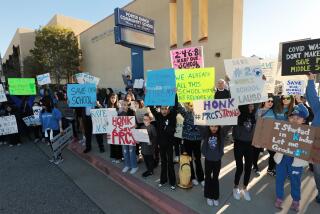Schools fail to win restoration of anti-poverty funds

More than two dozen local schools face reduced funding next year as the Los Angeles school district concentrates dollars at campuses with a higher percentage of low-income students.
The tighter budgets affect 28 schools next year, including the Sherman Oaks Center for Enriched Studies, Chatsworth and Westchester high schools and Walgrove Elementary. Some of these schools are relatively high-performing academically.
Contingents from these schools argued for a reprieve at Tuesday’s Board of Education meeting. But a measure to restore the funding fell just short of a majority on the seven-member body.
The proposal would have returned federal anti-poverty dollars to schools where just under half the students come from low-income families. L.A. Unified gets this funding for every low-income student, but the money doesn’t necessarily follow the student. Instead, the dollars go to schools with the highest concentration of poverty. The goal is to address the cumulative effects of intense pockets of poverty, which describes much of the nation’s second-largest school system.
It’s up to L.A. Unified to decide where to draw the poverty line for these “Title 1” funds. For years, schools that are 40% low-income received some of the money. But in 2011, L.A. Unified redrew the line, limiting the funds to schools where at least half the students are low-income.
Rio Vista fell short by nine students, which will cost it $87,000 next year. That money paid for academic intervention, more hours for a nurse, a psychologist and teaching assistants, said Principal Pia Sadaqatmal.
Board member Tamar Galatzan argued for the restoration. She said it would cost the higher-poverty schools only $5 per student, dropping their federal anti-poverty aid from $502 to $497 per pupil. The restored schools would have received $277 per student.
But Monica Garcia, whose schools serve predominantly low-income areas, objected.
“Maybe we don’t understand poverty,” she said. “Five dollars is a lot… Poverty needs to be interrupted. Today we’re hearing from the people that the system works best for…Even when you take away privilege there is privilege in the system.”
She added: “I’m having a hard time understanding how the kids at the most successful schools are being somehow harmed in the organization of this district.”
Galatzan countered that affected schools are successful, in part, because they’ve used their anti-poverty funds so well, and, in many cases, have become attractive enough to lure back some middle-class families.
“These schools are being penalized because they’ve done exactly what we’ve asked them to do,” she said later. “We’re forcing these schools to crash and burn before we’ll come to their rescue with any extra dollars.”
But her motion failed when Bennett Kayser abstained, saying he sympathized with both sides. The supporting votes were cast by Galatzan, Monica Ratliff and Steve Zimmer. Joining Garcia in voting no were Richard Vladovic and Marguerite Poindexter LaMotte.
ALSO:
‘Arab’ mascot: School officials to take public input at meeting
Man’s body found in fire-charred tent behind house in Riverside
Youth pastor slain in Pomona remembered as ‘big brother’ at vigil
Twitter: @howardblume
More to Read
Start your day right
Sign up for Essential California for news, features and recommendations from the L.A. Times and beyond in your inbox six days a week.
You may occasionally receive promotional content from the Los Angeles Times.






